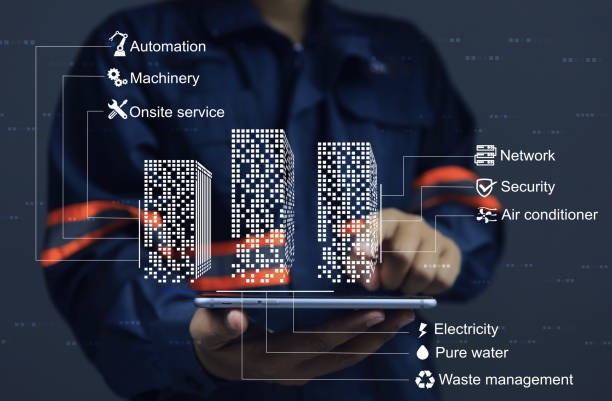Many types of building management systems exist. Their craftsmanship and features are unique. Before you select a suitable BMS for your commercial or residential property, understand how various systems work. A BMS provides one dashboard that can monitor, control, and optimize your HVAC, surveillance devices, alarms, and lighting equipment.
As the popularity of this advanced software system skyrockets, you must choose the ideal type for your needs. This detailed article outlines and compares the features of different BMS types. Read on to gather the knowledge you need to implement a robust BMS in your property.
Discover 5 Types of Building Management Systems
Property owners and managers have access to around of different types of building management systems. Check these descriptions to discover the features of the top five BMS options:
1. Centralized BMS
A centralized building management system refers to a control center with a single interface or dashboard. Centralization allows a building manager or owner to supervise and manage lighting, security, heating, ventilation, and air conditioning at once. It has various components, including:
- Sensors – A building management system uses a network of sensors to monitor different areas of a building and collect data in real-time.
- Actuators and controllers – These features work together to make a building more comfortable and safe. The controllers analyze and process live data from sensors. Then, they trigger the actuators within the BMS to do various optimization tasks.
- Dashboard – Various types of building management systems come with dashboards or UIs (user interfaces) that facilitate user interactions. These dashboards present status updates and alerts, allowing the facility manager or owner to respond fast. It is a control panel with every tool the manager needs to configure control schedules and techniques.
- Communication Network – This refers to a feature that uses Modbus or other advanced protocols to enable data exchange between BMS components.
- Analytics – A BMS also comes with analytical tools, including technologically advanced algorithms to detect faults and occupancy patterns and enhance the BMS’s performance over time.
A centralized BMS works efficiently to ensure energy savings and cost reduction. It is a scalable platform that suits buildings of all sizes and complexities. A centralized BMS has its disadvantages, including widespread disruption of operations whenever the central control system fails. Secondly, implementing a centralized BMS in a multifaceted building can be tricky without professional intervention.

2. Decentralized BMS
Decentralized types of building management systems have become viable substitutes for centralized systems because of their versatility. A decentralized BMS uses a broad architecture rather than a single control center.
Their control, monitoring, and optimization functions scatter across the sub-systems within the building. Like a centralized BMS, a decentralized system has features like sensors, actuators, controllers, UIs, and communication networks.
Every subsystem has a set of features, unlike the centralized BMS that uses one set. Thus, the subsystems work independent of each other. If one subsystem experiences a technical fault, the other units will continue to operate uninterrupted. This is its main advantage over the centralized BMS and other types of building automation systems.
Although a centralized BMS is scalable, it is less flexible than the decentralized one. The latter is easier to alter and expand without total reconfiguration of the entire software. The distributed approach allows each subsystem to adapt itself to the surroundings, releasing more accurate updates and data for improving building performance.
Although a decentralized BMS is more advantageous than the centralized one, users can face integration difficulties. Trying to connect dissimilar subsystems to achieve seamless communication between them can get tricky.
Additionally, decentralized building management systems are generally complex because of several subsystems. They require more cautious configuration and management.
3. Integrated BMS
Another of the most popular types of building management systems is the integrated BMS. As the word “integrated” suggests, this BMS connects equipment for air conditioning, fire safety, surveillance, ventilation, and lighting levels in a seamless manner.
An integrated BMS unifies these to ensure cross-system interaction and management. It uses cutting-edge software to allow communication among diverse systems. Integrated BMSs interpret live data as it emerges, allowing actuators to improve building performance and increase the users’ comfort. It uses open communication protocols like Modbus, BACnet, and LonWorks to enable seamless data exchange.
Moreover, an integrated BMS has more technologically advanced interfaces and gateways than the traditional systems. Its unified UI gathers and consolidates data from different systems within a building, offering the property manager or owner a comprehensive performance view. It guarantees better performance because of integrating different systems that produce unique data insights. Much like integrated communications solutions streamline the way organizations manage voice, data, and messaging. An integrated BMS eliminates silos and enhances efficiency by bringing multiple systems under one roof.
An integrated BMI centralizes monitoring, control, and management just like the centralized BMS. However, its more streamlined approach reduces complexity and facilitates quick troubleshooting and maintenance. Another advantage of these types of building management systems is that they increase visibility for property managers.
They display a view of building operations in real-time, encouraging prompt and accurate decision-making when the conditions change. Although these have many benefits, they also present some challenges.
For instance, integrating various systems with varying technological features can be complex without actual expertise. Moreover, the initial cost of implementing integrated building systems and maintaining them later on is higher than the centralized and decentralized systems’.
4. Cloud-based BMS
Cloud-based types of building management systems are reliable options because of their unparalleled scalability, flexibility, and remote accessibility. These are the best alternatives for those still using the inflexible legacy building management systems.
Cloud-based building management systems use the renowned cloud computing technology to store data in remote servers. They are better than traditional BMS options because of more scalability. If your properties grow in size and complexity, you can still rely on the same cloud-based BMS to monitor, control, and manage them.
Since this BMS lives on the cloud, you can view it from anywhere as long as you have a strong internet connection. Accessibility outside the property is easier than what a centralized, decentralized, or an integrated BMS can offer.
Even if you have a power outage or a hardware failure, you can still monitor and control your building operations via a cloud-based BMS. Since you will host your BMS and data on a third-party server, the initial installation cost is low.
The subscription-based cost is lower than the prices of installing premised-based centralized, decentralized, or integration-based building management systems. Regardless of having many benefits, a cloud-based BMS is prone to data security and privacy issues.
If the vendor lacks robust cyber security measures, they can expose your data to unauthorized access. These can lead to cyber threats and other security breaches.
5. Smart Building BMS
Smart types of building management systems are options that easily integrate with Internet of Things devices. This integration allows smart buildings to collect accurate data on humidity, temperature, lighting level, security status, and power consumption. With master system integration, all these IoT-enabled functions can be unified into a single cohesive platform, ensuring seamless coordination and smarter decision-making.
The Smart building BMS uses advanced algorithms to interpret data from diverse building systems. It automates control methods to help the facility manager make quick and perfect decisions to help improve building operations and occupants’ comfort.
Their real-time monitoring capability puts them ahead of traditional types of building management systems. Managers get better visibility and ample time to troubleshoot and correct problems. Smart building BMS tools offer predictive analytics via smart algorithms that can study data trends and predict possible problems and other outcomes.
They identify chances for energy conservation, leading to lower operation costs. A smart building BMS implementation can be impossible without expert intervention. The integration with IoT devices and sensors from various manufacturers can make the task even harder.
Final Thoughts
Property managers and owners have access to many types of building management systems. From centralized to decentralized to cloud-based building management systems, everyone can get an appropriate product for their needs.
As you select the correct one, consider different features and how the BMS works. Prioritize data security and privacy when investigating BMS options like cloud-based and smart building.





